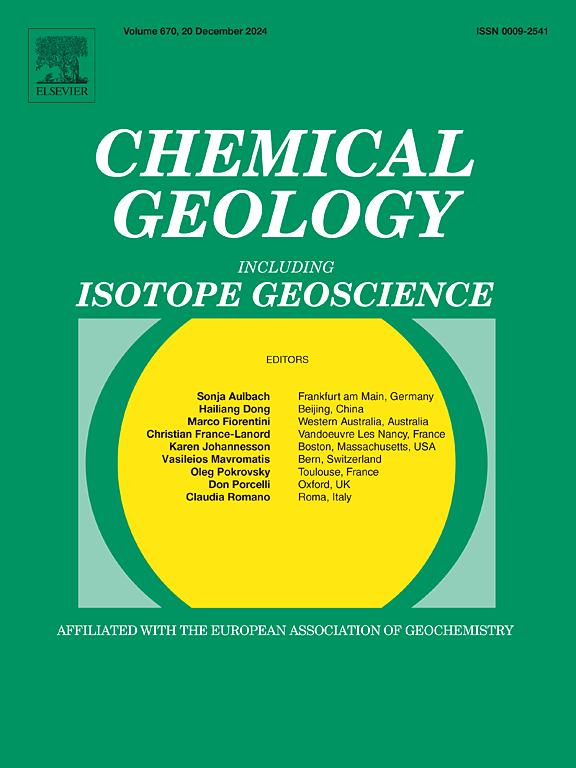Temperature effects on the reduction of Se(VI) by natural pyrite
IF 3.6
2区 地球科学
Q1 GEOCHEMISTRY & GEOPHYSICS
引用次数: 0
Abstract
79Se is a key radionuclide concerned in the geological disposal of high-level radioactive waste. Unlike lower valent Se(IV), previous studies have reported that the reduction of aqueous Se(VI) into insoluble Se0 or FeSe2 by pyrite is challenging under ambient temperatures. Considering the thermal environment of radioactive waste repositories and the widespread presence of pyrite in the host rocks, this study investigated Se(VI) reduction by natural arsenic-scarce and arsenic-rich pyrites, namely Py@TL and Py@LY, respectively, under conditions of pH ∼2.0 to ∼9.0 and temperatures ranging from 25 °C to 85 °C. The results reveal that elevated temperatures and acidic conditions significantly enhance Se(VI) reduction via a Se(IV) intermediate to form insoluble nanoscale Se0 clusters along with Se-S compounds, following a pseudo-zero-order kinetic model. The apparent activation energy (Ea) values were determined to be 40.5 ± 2.4 and 59.1 ± 3.0 kJ⋅mol−1 for Se(VI) reduction by the arsenic-scarce Py@TL, and 51.0 ± 1.8 and 63.2 ± 12.6 kJ⋅mol−1 for the arsenic-rich Py@LY, at pH ∼2.0 and ∼2.5, respectively. These Ea values highlight surface chemical reactions as the rate-determining step, elucidating the inertness of Se(VI) on pyrite surfaces at ambient temperatures. Notably, arsenic impurities in Py@LY appear to enhance the reactivity by modifying the local structure of pyrite, but excessive Fe2+, As3+ competition, and solid layers of As0 and S0 impede the reduction process and elevate the apparent Ea. These findings provide novel insights into Se(VI) reduction mechanisms under complex geochemical conditions.

求助全文
约1分钟内获得全文
求助全文
来源期刊

Chemical Geology
地学-地球化学与地球物理
CiteScore
7.20
自引率
10.30%
发文量
374
审稿时长
3.6 months
期刊介绍:
Chemical Geology is an international journal that publishes original research papers on isotopic and elemental geochemistry, geochronology and cosmochemistry.
The Journal focuses on chemical processes in igneous, metamorphic, and sedimentary petrology, low- and high-temperature aqueous solutions, biogeochemistry, the environment and cosmochemistry.
Papers that are field, experimentally, or computationally based are appropriate if they are of broad international interest. The Journal generally does not publish papers that are primarily of regional or local interest, or which are primarily focused on remediation and applied geochemistry.
The Journal also welcomes innovative papers dealing with significant analytical advances that are of wide interest in the community and extend significantly beyond the scope of what would be included in the methods section of a standard research paper.
 求助内容:
求助内容: 应助结果提醒方式:
应助结果提醒方式:


